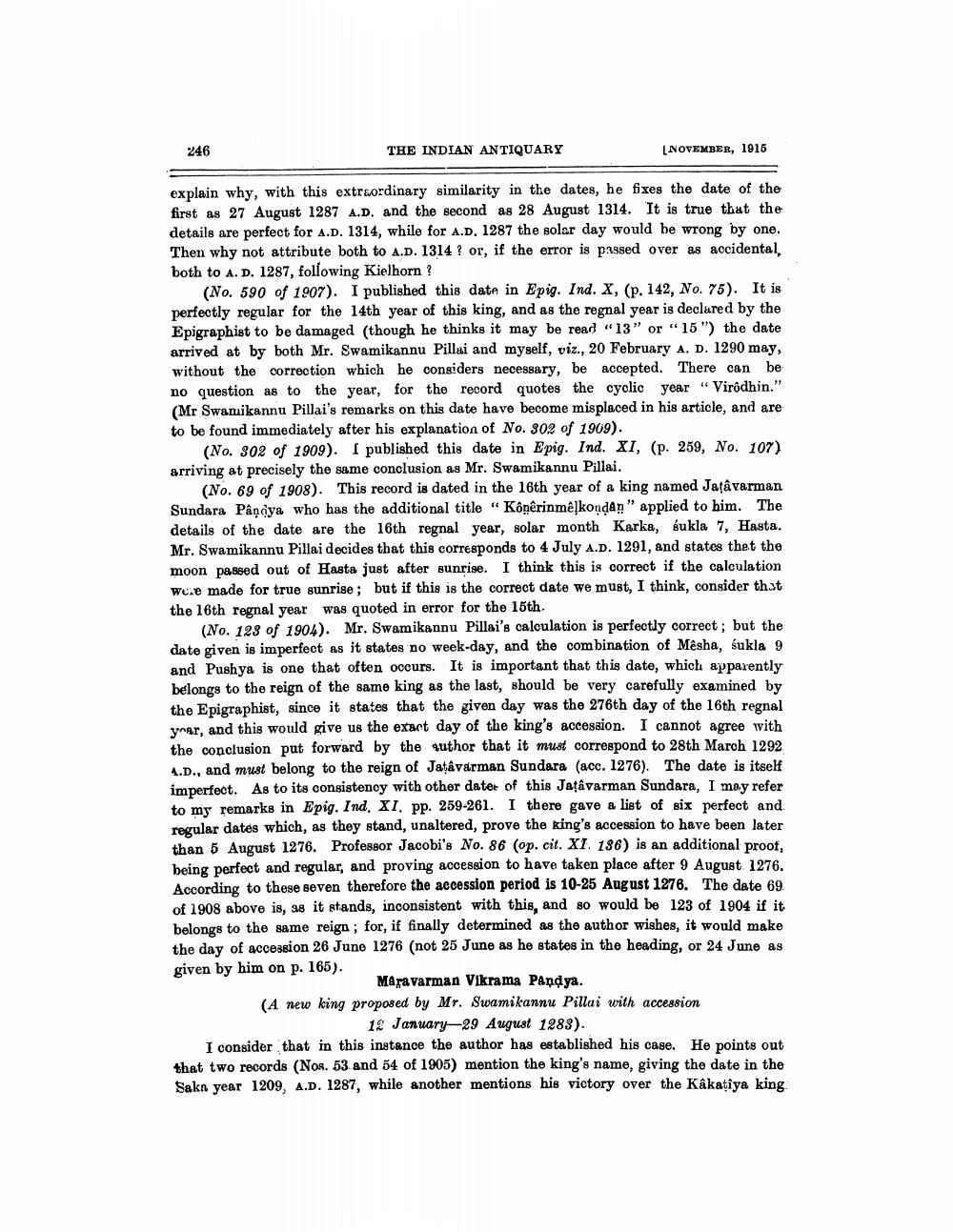________________
246
THE INDIAN ANTIQUARY
NOVEMBER, 1915
explain why, with this extraordinary similarity in the dates, he fixes the date of the first as 27 August 1287 A.D. and the second as 28 August 1314. It is true that the details are perfect for A.D. 1314, while for A.D. 1287 the solar day would be wrong by one. Then why not attribute both to A.D. 1314 ? or, if the error is passed over as accidental, both to A.D. 1287, following Kielhorn ?
(No. 590 of 1907). I published this date in Epig. Ind. X, (p. 142, No. 75). It is perfectly regular for the 14th year of this king, and as the regnal year is declared by the Epigraphist to be damaged (though he thinks it may be read "13" or "15") the date arrived at by both Mr. Swamikannu Pillai and myself, viz., 20 February A. D. 1290 may, without the correction which he considers necessary, be accepted. There can be no question as to the year, for the record quotes the cyclic year “Virôdhin." (Mr Swamikannu Pillai's remarks on this date have become misplaced in his article, and are to be found immediately after his explanation of No. 302 of 1909).
(No. 302 of 1909). I published this date in Epig. Ind. XI, (p. 259, No. 107) arriving at precisely the same conclusion as Mr. Swamikannu Pillai.
(No. 69 of 1908). This record is dated in the 16th year of a king named Jatâvarman Sundara Pandya who has the additional title "Konêrinmêlkondan" applied to him. The details of the date are the 16th regnal year, solar month Karka, sukla 7, Hasta. Mr. Swamikannu Pillai decides that this corresponds to 4 July A.D. 1291, and states that the moon passed out of Hasta just after sunrise. I think this is correct if the calculation wee made for true sunrise ; but if this is the correct date we must, I think, consider that the 16th regnal year was quoted in error for the 15th.
(No. 123 of 1904). Mr. Swamikannu Pillai's calculation is perfectly correct; but the date given is imperfect as it states no week-day, and the combination of Mêsha, sukla 9 and Pushya is one that often occurs. It is important that this date, which apparently belongs to the reign of the same king as the last, should be very carefully examined by the Epigraphist, since it states that the given day was the 276th day of the 16th regnal yrar, and this would give us the exact day of the king's accession. I cannot agree with the conclusion put forward by the quthor that it must correspond to 28th March 1292 A.D., and must belong to the reign of Jatâ varman Sundara (acc. 1276). The date is itself imperfect. As to its consistency with other dater of this Jatavarman Sundara, I may refer to my remarks in Epig. Ind. XI, pp. 259-261. I there gave a list of six perfect and regular dates which, as they stand, unaltered, prove the king's accession to have been later than 5 August 1276. Professor Jacobi's No. 86 (op. cit. XI. 186) is an additional proof, being perfect and regular, and proving accession to have taken place after 9 August 1276. According to these seven therefore the accession period is 10-25 August 1276. The date 69. of 1908 above is, as it stands, inconsistent with this, and so would be 123 of 1904 if it belongs to the same reign; for, if finally determined as the author wishes, it would make the day of accession 26 June 1276 (not 25 June as he states in the heading, or 24 June as given by him on p. 165).
Maravarman Vikrama Pandya. (A new king proposed by Mr. Swamikannu Pillai with accession
12 January-29 August 1283). I consider that in this instance the author has established his case. He points out that two records (Nos. 53 and 54 of 1905) mention the king's name, giving the date in the Sakn year 1209, A.D. 1287, while another mentions his victory over the Kakatiya king




